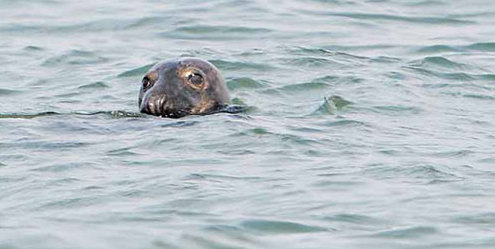Tracking evolutions of flu in mammals
Updated: 2012-08-12 07:53
By Carl Zimmer (The New York Times)
|
|||||||||||
|
|
In September 2011, beachgoers noticed dead harbor seal pups on New Hampshire beaches. "Surfers were surfing into seals floating in the water," said Katie Pugliares, a senior biologist with the New England Aquarium's rescue program.
Unlike typical seal cadavers, the seals were not malnourished, suggesting they had died suddenly.
In a paper published July 31 in the journal mBio, a team of scientists reports that the pups were killed by a new strain of influenza. Their research indicates that the virus evolved from bird flu, gaining the ability to spread from seal to seal.
A strain of the flu never seen in seals, the virus belongs to a flu subtype known as H3N8. H3N8 viruses have crossed over from birds to dogs and horses several times since 1960.
The scientists who searched for the origin of the seal virus said the closest relative is a virus isolated in Ohio in 2002 from a species of duck called the blue-winged teal.
They identified 37 mutations that set the seal virus apart from bird flu. A number have been previously documented as important for flu viruses to adapt to mammal hosts.
A new strain that can spread among seals is a reason for serious concern, said Simon Anthony, a postdoctoral researcher at the Center for Infection and Immunity at Columbia University in New York.
"What we fear is that it would allow the virus to persist within the seal population," he said. "And if it persists, who knows what other changes may accumulate over time?"
W. Ian Lipkin, the center's director, said, "If it adapts better to mammal hosts, it may well start to move into humans." He added, "This is clearly a virus for which we need some surveillance."
All human flu strains, including the one that emerged in 1918 to kill about 50 million people, have evolved from flu viruses that live in birds and pass through them into mammals.
Once in mammals, the flu strain can mutate and infect humans.
To understand how these transitions happen, scientists tried tinkering with a strain of bird flu to see how many mutations it takes until it spreads from mammal to mammal. Earlier this year they described how a few mutations of a strain called H5N1 enabled it to spread among ferrets.
But, responding to worries about an accidental release of an engineered virus, flu scientists agreed in January to a moratorium on further research.
Pigs, Dr. Lipkin said, are especially good at producing new flu strains because they can be infected by bird flu and mammal flu at the same time. Two kinds of virus can combine, giving rise to new hybrid strains.
Dr. Lipkin and his colleagues found evidence that seal cells can also be invaded by both kinds of viruses - raising the possibility that they too could produce new hybrid flu strains.
"It could be the equivalent of an aquatic pig," Dr. Lipkin said.
Eddie Holmes, an expert on flu evolution at Pennsylvania State University, wanted to see more evidence for the idea that flu viruses can mix in seals. He also pointed out that H3N8 has never crossed from dogs or horses to people.
"Just because we find a seal with mammal-adapted H3N8 does not mean we're going to get a human pandemic," Dr. Holmes said. "At the moment, it's hard to say what the threat really is."
Still, Dr. Pugliares will be on the lookout for a new outbreak in September on the beaches of New England. And she and her colleagues will be taking extra precautions with any seals that show signs of the flu.
"We are going to definitely step it up a notch," she said.
The New York Times
Today's Top News
President Xi confident in recovery from quake
H7N9 update: 104 cases, 21 deaths
Telecom workers restore links
Coal mine blast kills 18 in Jilin
Intl scholarship puts China on the map
More bird flu patients discharged
Gold loses sheen, but still a safe bet
US 'turns blind eye to human rights'
Hot Topics
Lunar probe , China growth forecasts, Emission rules get tougher, China seen through 'colored lens', International board,
Editor's Picks

|

|

|

|

|

|






